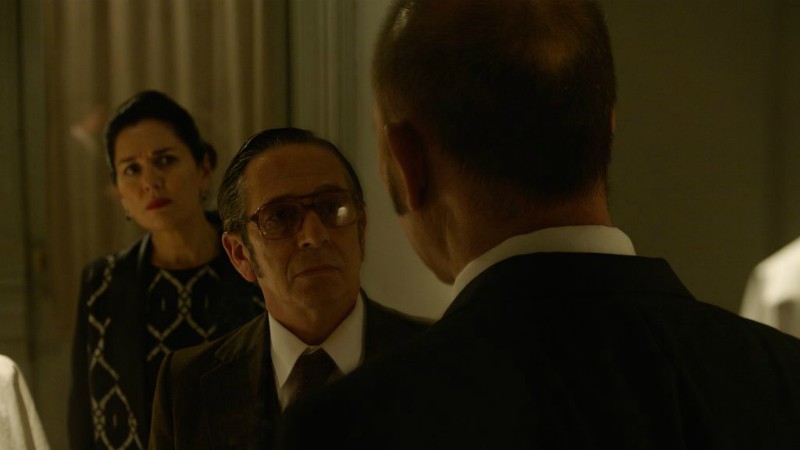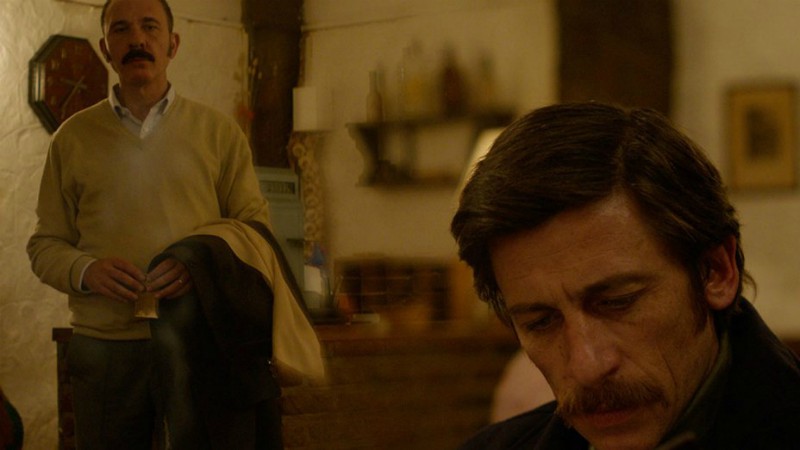Professor Marcelo Pena (Marcelo Subiotto) teaches at the prestigious Philosophy Faculty of the Buenos Aires University, popularly known as Puan (named after the street and the local metro station). Head Professor Eduardo Caselli dies unexpectedly of a heart attack while jogging, leaving Marcelo scrambling to pick up the pieces and potentially his much coveted position. He is a popular lecturer, passionate and devoted to his profession. But his methods may be slightly obsolete, while his finances may prevent him from providing a dignified existence to his family. In one of the film’s first scene, he sits on baby’s poo and has to walk around covering in faeces. This embarrassing event is symbolic of Marcelo’s broader predicament: he must forge ahead covered in shit.
Much younger, charismatic and good-looking professor Rafael Sujarchuk (Leonardo Sbaraglia) poses a real challenge to Marcelo. He has studied in Frankfurt, speaks German, sings in French, plays the piano and is married to a famous and ultra-beautiful actress. Far more crucially, students flock to his lessons, leaving Marcelo’s classroom virtually empty. He fears that the vaguely cocky yet warm and friendly man could become a far more suitable successor to the late Eduardo, should he apply for the newly available position.
Puan is constructed upon philosophical references, with university lessons and very scholarly conversations providing the backbone to the film structure. Marcelo discusses Heidegger’s “Dasein”, Heraclitus’s “universal flux”, Plato’s musings on death, Socrates, Parmenides, Camus, Hobbes and many others. A little esoteric for outsiders. And also a little soporific. Perhaps for this very reason, Marcelo’s octogenarian private student falls asleep halfway through her lesson. The banalisation of philosophy is one of the movie’s central topics. The same student insists that Marcelo delivers a “philosophy show” on her 85th birthday because the magician could not make it. He reluctantly agrees only because this may be her last such celebration. During the party, he is asked to come up with some “philosophical jokes” or “philosophical singing”, in the movie’s funniest and most cringeworthy scene. Puan mocks the idea that philosophy should be made in o entertainment. It seeks to find humour in the very notion that philosophy and comedy and incompatible. It’s only partly successful, with the story sometimes slipping into puerile platitudes. In a way, the film becomes a victim of its own pursuit for cleverness.
This 111-minute international co-production of five nations (three European and two Latin American) also questions the racist notion that philosophy is Eurocentric. A fellow professor notes to Marcelo that Latin American philosophy is called “thinking” instead. Marcelo retorts that the continent where Argentina is located does not have such a strong philosophy movement. At the end of the film, however, it becomes clear that Latin America has forged a strong connection between philosophy and political militancy, as what started out as lighthearted philosophical comedy morphs into an activist film. While never mentioned by name, the revolutionary teachings of Brazilian philosopher and educator (who proposes thinking as a weapon against political repression) seem to permeate every aspect of the film. The largest country of South America is topically present throughout: police repression, teacher violence, the elitism of philosophy are themes very close to the heart of Brazilians. Posters of Brazilian president Lula are seen a few times: they are a token of the progressive left-wing. And I could almost hear Brazilian composer Caetano Veloso sing: “if you have an incredible idea, then you should write a song, it’s been proven that it’s only possible to philosophise in German” (free translation, from the song “Língua”)
The shadow of obscurantism is never far from Latin America. Two far-right candidates are on the lead as Argentina heads to the polls in a few weeks. Puan reminds viewers of the country’s tragic history of fascist oppression by showcasing a wall covered with images of people gone missing during the violent dictatorship that ruled Argentina from 1976 to 1983, while also inviting viewers to arm themselves with knowledge. The university is one of the last and most sacred bastions of critical freedom, one of the most effective weapons against political deception
Puan premiered in the Official Competition of the 71st San Sebastian International Film Festival, when this piece was originally written. Also showing at the 41st Turin Film Festival:










